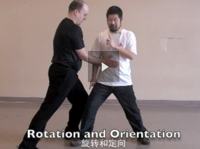“Nobody has the patience to wait and spin. If I am reacting and someone is pushing, and I wait until he has enough friction, I spin and it works. But if I’m too impatient, he pushes and I move forward or backward instead of spin; it becomes a toss, because I go too early. That’s why you have to be patient, and you have to follow the rules. Following the rules is very difficult because when we see an opportunity we want to fight. And in taiji, the rules say you can’t. Even if he’s not blocking […] you have to wait until he comes in and then you can spin him.”
Original article: https://practicalmethod.com/2011/08/chen-zhonghua-on-peng-energy-on-chen-style-taijiquan/
I like this paragraph very much.



{ 7 comments… read them below or add one }
The way I understand this is just wait till he pushes enough pressure on your structure and you can spin him out using superior Taiji shenfa. In practice however it seems indeed very difficult.
I wonder what Master Chen’s thoughts are on enticing strategies to get an opponent first to commit or over-commit such as in this youtube video where the sifu talks explains “wen jin”. To use a persons reaction to throw him out before too much “friction” has landed on the body. Do you guys think these enticing methods have a place in The Practical Method? Hopefully it isn’t against the rules to post videos from other Taiji schools.
http://www.youtube.com/watch?v=bYFcUxep9TE&feature=relmfu
Of course it is OK to post anything on this site. It is very difficult to comment on things that are not from our school because the rules are different.
How so? Re the Q “Do you guys think these enticing methods have a place in The Practical Method?”-ALHKC.
Not commenting seems to imply that there is a negative view about enticing methods, does that mean they are not used / needed in the ‘practical method training?? This confuses me….
I understood (from other online discussion) that fajin requires force to react against and that in circumstances where none is offered (in ‘contest’) one increases own force by an ‘advance’ which in turn initiates a positive reaction from the opponent, and creates the window of opportunity (ie creates /enables the force required) to send the opponent off. I would interpret that as an enticing method….please comment.
I am not well experienced from a practical standpoint however … alhkc Many thanks for that link!
The students in the video were taught to follow their teacher/sifu moving back and forth. Therefore, they had no roots whatsoever. It’s rather easy to toss them around. (Easier than you expected. I used to do that to my students and looked pretty impressive, too. Now, after a few years of practical method training, I “lost” that ability. Why? Because my students won’t be enticed by me. They developed “roots.” Worse than that, if I tried to move back and forth, they could push me out easily. No joking.)
“Not commenting seems to imply that there is a negative view about enticing methods, does that mean they are not used / needed in the ‘practical method training?? This confuses me….”
Most of your comments are very useful and logical but the above comment and conclusion CONFUSES me.
I’m currently a practitioner of what I would call traditional Chen tai chi or the clossest approximation of of it in Canada. I’ve been fascinated by the teachings that I’ve seen on youtube of the practical method of Chen Tai Chi, but it has raised some questions for me. Are there many fundamental differences between the two forms of practice or are they fundamentally the same? Just curious.
“traditional Chen tai chi or the clossest approximation of of it” is not a particular style so it is not possible to make a comparison. On the other hands, all styles and forms of taiji should be fundamentally the same as they are all based on the same philosophy, principle and rules.